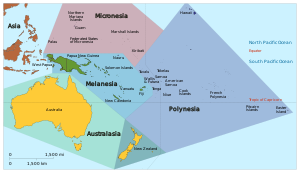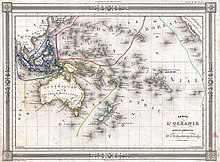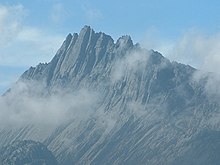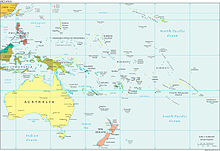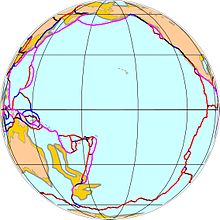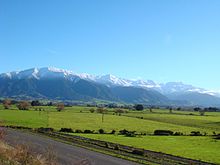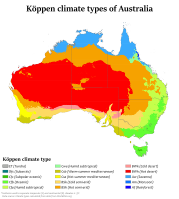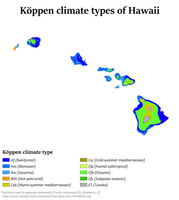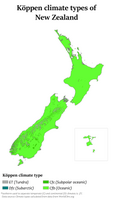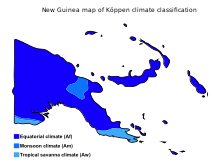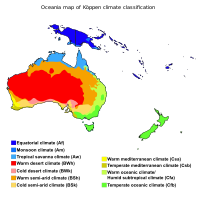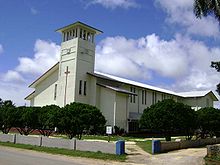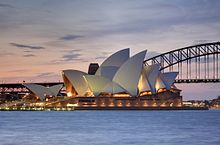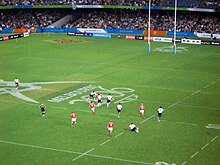 | |
| Area | 8,525,989 km2 (3,291,903 sq mi) |
|---|---|
| Population | 40,117,432 (2016, 6th)[1] |
| Population density | 4.19/km2 (10.9/sq mi) |
| GDP (nominal) | $1.468 trillion (2016, 6th) |
| GDP per capita | $37,107 (2015, 2nd)[2] |
| Demonym | Oceanian |
| Countries | |
| Dependencies | |
| Languages | |
| Time zones | UTC+14 (Kiribati) to UTC-11 (American Samoa and Niue) (West to East) |
Oceania (UK: /ˌoʊsiˈɑːniə,
The islands at the geographic extremes of Oceania are Bonin Islands, a politically integral part of Japan; Hawaii, a state of the United States; Clipperton Island, a possession of France; the Juan Fernández Islands, belonging to Chile; the Campbell Islands, belonging to New Zealand; and the Cocos (Keeling) Islands, belonging to Australia. Oceania has a diverse mix of economies from the highly developed and globally competitive financial market of Australia and New Zealand, which rank high in quality of life and human development index, to the much less developed economies that belong to countries such as of Kiribati and Tuvalu while also including medium-sized economies of Pacific islands such as Palau, Fiji and Tonga. The largest and most populous country in Oceania is Australia, with Sydney being the largest city of both Oceania and Australia.
The first settlers of Australia, New Guinea, and the large islands just to the east arrived between 50,000 and 30,000 years ago. Oceania was first explored by Europeans from the 16th century onward. Portuguese navigators, between 1512 and 1526, reached the Tanimbar Islands, some of the Caroline Islands and west Papua New Guinea. On his first voyage in the 18th century, James Cook, who later arrived at the highly developed Hawaiian Islands, went to Tahiti and followed the east coast of Australia for the first time.[10] The Pacific front saw major action during the Second World War, mainly between Allied powers the United States and Australia, and Axis power Japan.
The arrival of European settlers in subsequent centuries resulted in a significant alteration in the social and political landscape of Oceania. In more contemporary times there has been increasing discussion on national flags and a desire by some Oceanians to display their distinguishable and individualistic identity.[11] The rock art of Australian Aborigines is the longest continuously practiced artistic tradition in the world.[12] Puncak Jaya in Papua is often considered the highest peak in Oceania.[13] Most Oceanian countries have a parliamentary representative democratic multi-party system, with tourism being a large source of income for the Pacific Islands nations.[14]
Definitions
Regions of Oceania
The term was coined as Océanie circa 1812 by geographer Conrad Malte-Brun.[15] The word Océanie is a French word derived from the Latin word oceanus, and this from the Greek word ὠκεανός (ōkeanós), ocean. Natives and inhabitants of this region are called Oceanians or Oceanicans.[16] The term Oceania is used because, unlike the other continental groupings, it is the ocean that links the nations together.[17]
- Biogeographically, as a synonym for the Australasian ecozone and the Pacific ecozone (Melanesia, Polynesia, and Micronesia), with New Zealand forming the south-western corner of the Polynesian Triangle. To note, New Zealand may also be considered part of Australasia, despite being traditionally part of Polynesia.[18]
- As an ecozone, Oceania includes all of Micronesia, Fiji, and all of Polynesia except New Zealand. New Zealand, along with New Guinea and nearby islands, part of the Philippine islands, Australia, the Solomon Islands, Vanuatu, and New Caledonia, constitute the separate Australasian ecozone.[19]
- In the geopolitical conception used by the United Nations, International Olympic Committee, and many atlases, Oceania includes Australia and the nations of the Pacific from Papua New Guinea east, but not Indonesian New Guinea.[20]
History
Australia
A 19th-century engraving of an Aboriginal Australian encampment
Indigenous Australians are the original inhabitants of the Australian continent and nearby islands who migrated from Africa to Asia around 70,000 years ago[21] and arrived in Australia around 50,000 years ago.[22] They are believed to be among the earliest human migrations out of Africa.[23]
Although they likely migrated to Australia through Southeast Asia they are not demonstrably related to any known Asian or Polynesian population.[24] There is evidence of genetic and linguistic interchange between Australians in the far north and the Austronesian peoples of modern-day New Guinea and the islands, but this may be the result of recent trade and intermarriage.[25]
They reached Tasmania approximately 40,000 years ago by migrating across a land bridge from the mainland that existed during the last ice age.[26] It is believed that the first early human migration to Australia was achieved when this landmass formed part of the Sahul continent, connected to the island of New Guinea via a land bridge.[27] The Torres Strait Islanders are indigenous to the Torres Strait Islands, which are at the northernmost tip of Queensland near Papua New Guinea.[28] The earliest definite human remains found in Australia are that of Mungo Man, which have been dated at about 40,000 years old.[29]
Melanesia
Distribution of Melanesians
The original inhabitants of the group of islands now named Melanesia were likely the ancestors of the present-day Papuan-speaking people. Migrating from South-East Asia, they appear to have occupied these islands as far east as the main islands in the Solomon Islands, including Makira and possibly the smaller islands farther to the east.[30]
Particularly along the north coast of New Guinea and in the islands north and east of New Guinea, the Austronesian people, who had migrated into the area somewhat more than 3,000 years ago, came into contact with these pre-existing populations of Papuan-speaking peoples. In the late 20th century, some scholars theorized a long period of interaction, which resulted in many complex changes in genetics, languages, and culture among the peoples.[31]
Polynesia
Moai at Ahu Tongariki on Rapa Nui (Easter Island)
The Polynesian people are considered to be by linguistic, archaeological and human genetic ancestry a subset of the sea-migrating Austronesian people and tracing Polynesian languages places their prehistoric origins in the Malay Archipelago, and ultimately, in Taiwan. Between about 3000 and 1000 BC speakers of Austronesian languages began spreading from Taiwan into Island South-East Asia,[32][33][34] as tribes whose natives were thought to have arrived through South China about 8,000 years ago to the edges of western Micronesia and on into Melanesia.
In the archaeological record there are well-defined traces of this expansion which allow the path it took to be followed and dated with some certainty. It is thought that by roughly 1400 BC,[35] "Lapita Peoples", so-named after their pottery tradition, appeared in the Bismarck Archipelago of north-west Melanesia.[36][37]
Easter Islanders claimed that a chief Hotu Matu'a[38] arrived on the island in one or two large canoes with his wife and extended family.[39] They are believed to have been Polynesian. Published literature suggests the island was settled around AD 300–400, or at about the time of the arrival of the earliest settlers in Hawaii. Around 1200, Tahitian explorers found and began settling the area. This date range is based on glottochronological calculations and on three radiocarbon dates from charcoal that appears to have been produced during forest clearance activities.[40] Moreover, a recent study which included radiocarbon dates from what is thought to be very early material suggests that the island was settled as recently as 1200.[41]
Micronesia
Stone money transport to Yap Island in Micronesia (1880)
Micronesia began to be settled several millennia ago, although there are competing theories about the origin and arrival of the first settlers. There are numerous difficulties with conducting archaeological excavations in the islands, due to their size, settlement patterns and storm damage. As a result, much evidence is based on linguistic analysis.[42]
The earliest archaeological traces of civilization have been found on the island of Saipan, dated to 1500 BC or slightly before. The ancestors of the Micronesians settled there over 4,000 years ago. A decentralized chieftain-based system eventually evolved into a more centralized economic and religious culture centered on Yap and Pohnpei.[43] The prehistory of many Micronesian islands such as Yap are not known very well.[44]
The first people of the Northern Mariana Islands navigated to the islands at some period between 4000 BC to 2000 BC from South-East Asia. They became known as the Chamorros, and spoke an Austronesian language called Chamorro. The ancient Chamorro left a number of megalithic ruins, including Latte stone. The Refaluwasch, or Carolinian, people came to the Marianas in the 1800s from the Caroline Islands. Micronesian colonists gradually settled the Marshall Islands during the 2nd millennium BC, with inter-island navigation made possible using traditional stick charts.[45]
European exploration
1852 map of Oceania by J. G. Barbie du Bocage. Includes regions of Polynesia, Micronesia, Melanesia and Malaysia.
From 1527 to 1595 a number of other large Spanish expeditions crossed the Pacific Ocean, leading to the discovery of the Marshall Islands and Palau in the North Pacific, as well as Tuvalu, the Marquesas, the Solomon Islands, the Cook Islands and the Admiralty Islands in the South Pacific.[46]
In the quest for Terra Australis, Spanish explorations in the 17th century, such as the expedition led by the Portuguese navigator Pedro Fernandes de Queirós, discovered the Pitcairn and Vanuatu archipelagos, and sailed the Torres Strait between Australia and New Guinea, named after navigator Luís Vaz de Torres. Willem Janszoon, made the first completely documented European landing in Australia (1606), in Cape York Peninsula.[47] Abel Janszoon Tasman circumnavigated and landed on parts of the Australian continental coast and discovered Van Diemen's Land (now Tasmania), New Zealand in 1642, and Fiji islands.[48] He was the first known European explorer to reach these islands.[49]
On 23 April 1770 British explorer James Cook made his first recorded direct observation of indigenous Australians at Brush Island near Bawley Point.[50] On 29 April, Cook and crew made their first landfall on the mainland of the continent at a place now known as the Kurnell Peninsula. It is here that James Cook made first contact with an aboriginal tribe known as the Gweagal. His expedition became the first recorded Europeans to have encountered its eastern coastline of Australia.[51]
Colonization
New Guinea from 1884 to 1919. The Netherlands controlled the western half of New Guinea, Germany the north-eastern part, and Britain the south-eastern part.
In 1789 the Mutiny on the Bounty against William Bligh led to several of the mutineers escaping the Royal Navy and settling on Pitcairn Islands, which later became a British colony. Britain also established colonies in Australia in 1788, New Zealand in 1840 and Fiji in 1872, with much of Oceania becoming part of the British Empire. The Gilbert Islands (now known as Kiribati) and the Ellice Islands (now known as Tuvalu) came under Britain's sphere of influence in the late 19th century.[52][53]
French Catholic missionaries arrived on Tahiti in 1834; their expulsion in 1836 caused France to send a gunboat in 1838. In 1842, Tahiti and Tahuata were declared a French protectorate, to allow Catholic missionaries to work undisturbed. The capital of Papeetē was founded in 1843.[54] On 24 September 1853, under orders from Napoleon III, Admiral Febvrier Despointes took formal possession of New Caledonia and Port-de-France (Nouméa) was founded 25 June 1854.[55]
The Spanish explorer Alonso de Salazar landed in the Marshall Islands in 1529. They were named by Krusenstern, after English explorer John Marshall, who visited them together with Thomas Gilbert in 1788, en route from Botany Bay to Canton (two ships of the First Fleet). In 1905 the British government transferred some administrative responsibility over south-east New Guinea to Australia (which renamed the area "Territory of Papua"); and in 1906, transferred all remaining responsibility to Australia. The Marshall Islands were claimed by Spain in 1874. Germany established colonies in New Guinea in 1884, and Samoa in 1900. The United States also expanded into the Pacific, beginning with Baker Island and Howland Island in 1857, and with Hawaii becoming a U.S. territory in 1898. Disagreements between the US, Germany and UK over Samoa led to the Tripartite Convention of 1899.[56]
Modern history
New Zealand troops land on Vella Lavella, in the Solomon Islands
One of the first land offensives in Oceania was the Occupation of German Samoa in August 1914 by New Zealand forces. The campaign to take Samoa ended without bloodshed after over 1,000 New Zealanders landed on the German colony. Australian forces attacked German New Guinea in September 1914. A company of Australians and a British warship besieged the Germans and their colonial subjects, ending with a German surrender.[57]
The attack on Pearl Harbor by the Japanese Imperial General Headquarters,[58][59] was a surprise military strike conducted by the Imperial Japanese Navy against the United States naval base at Pearl Harbor, Hawaii, on the morning of 7 December 1941. The attack led to the United States' entry into World War II. The Japanese subsequently invaded New Guinea, the Solomon Islands and other Pacific islands. The Japanese were turned back at the Battle of the Coral Sea and the Kokoda Track campaign before they were finally defeated in 1945. Some of the most prominent Oceanic battlegrounds were the Battle of Bita Paka, Solomon Islands campaign, the Air raids on Darwin, the Kokada Track, and the Borneo campaign.[60][61] The United States fought the Battle of Guam from July 21 to August 10, 1944, to recapture the island from Japanese military occupation.[62]
Australia and New Zealand became dominions in the 20th century, adopting the Statute of Westminster Act in 1942 and 1947 respectively. In 1946, Polynesians were granted French citizenship and the islands' status was changed to an overseas territory; the islands' name was changed in 1957 to Polynésie Française (French Polynesia). Hawaii became a U.S. state in 1959. Fiji and Tonga became independent in 1970. On 1 May 1979, in recognition of the evolving political status of the Marshall Islands, the United States recognized the constitution of the Marshall Islands and the establishment of the Government of the Republic of the Marshall Islands. The South Pacific Forum was founded in 1971, which became the Pacific Islands Forum in 2000.[57]
Geography
Aoraki / Mount Cook, located on the South Island of New Zealand
Puncak Jaya / Carstensz Pyramid, highest summit in Oceania
Oceania was originally conceived as the lands of the Pacific Ocean, stretching from the Strait of Malacca to the coast of the Americas. It comprised four regions: Polynesia, Micronesia, Malaysia (now called the Malay Archipelago), and Melanesia.[63] Today, parts of three geological continents are included in the term "Oceania": Eurasia, Australia, and Zealandia, as well the non-continental volcanic islands of the Philippines, Wallacea, and the open Pacific.
Oceania extends to New Guinea in the west, the Bonin Islands in the northwest, the Hawaiian Islands in the northeast, Rapa Nui and Sala y Gómez Island in the east, and Macquarie Island in the south. Not included are the Pacific islands of Taiwan, the Ryukyu Islands, the Japanese archipelago, and the Maluku Islands, all on the margins of Asia, and the Aleutian Islands of North America. In its periphery, Oceania sprawls 28 degrees north to the Bonin Islands in the northern hemisphere, and 55 degrees south to Macquarie Island in the southern hemisphere.[64]
Oceanian islands are of four basic types: continental islands, high islands, coral reefs and uplifted coral platforms. High islands are of volcanic origin, and many contain active volcanoes. Among these are Bougainville, Hawaii, and the Solomon Islands.[65]
Oceania is one of eight terrestrial ecozones, which constitute the major ecological regions of the planet. Related to these concepts are Near Oceania, that part of western Island Melanesia which has been inhabited for tens of millennia, and Remote Oceania which is more recently settled. Although the majority of the Oceanian islands lie in the South Pacific, a few of them are not restricted to the Pacific Ocean — Kangaroo Island and Ashmore and Cartier Islands, for instance, are situated in the Southern Ocean and Indian Ocean, respectively, and Tasmania's west coast faces the Southern Ocean.[66]
The coral reefs of the South Pacific are low-lying structures that have built up on basaltic lava flows under the ocean's surface. One of the most dramatic is the Great Barrier Reef off northeastern Australia with chains of reef patches. A second island type formed of coral is the uplifted coral platform, which is usually slightly larger than the low coral islands. Examples include Banaba (formerly Ocean Island) and Makatea in the Tuamotu group of French Polynesia.[67][68]
Regions
Micronesia, which lies north of the equator and west of the International Date Line, includes the Mariana Islands in the northwest, the Caroline Islands in the center, the Marshall Islands to the west and the islands of Kiribati in the southeast.[69][70]Melanesia, to the southwest, includes New Guinea, the world's second largest island after Greenland and by far the largest of the Pacific islands. The other main Melanesian groups from north to south are the Bismarck Archipelago, the Solomon Islands, Santa Cruz, Vanuatu, Fiji and New Caledonia.[71]
Polynesia, stretching from Hawaii in the north to New Zealand in the south, also encompasses Tuvalu, Tokelau, Samoa, Tonga and the Kermadec Islands to the west, the Cook Islands, Society Islands and Austral Islands in the center, and the Marquesas Islands, Tuamotu, Mangareva Islands, and Easter Island to the east.[72]
Australasia comprises Australia, New Zealand, the island of New Guinea, and neighbouring islands in the Pacific Ocean. Most of Australasia lies on the southern portion of the Indo-Australian Plate, flanked by the Indian Ocean to the west and the Southern Ocean to the south.[73] The bulk of Australasia sits on the Indo-Australian Plate, together with India.[74]
Various maps of Oceania
Geology
The Pacific Plate comprises most of Oceanian regions, excluding Australasia and western portion of Melanesia.
The Pacific Plate, which makes up most of Oceania, is an oceanic tectonic plate that lies beneath the Pacific Ocean. At 103 million square kilometres (40,000,000 sq mi), it is the largest tectonic plate. The plate contains an interior hot spot forming the Hawaiian Islands.[75] It is almost entirely oceanic crust.[76] The oldest member disappearing by way of the plate tectonics cycle is early-Cretaceous (145 to 137 million years ago).[77]
Australia, being part of the Indo-Australian plate, is the lowest, flattest, and oldest landmass on Earth[78] and it has had a relatively stable geological history. Geological forces such as tectonic uplift of mountain ranges or clashes between tectonic plates occurred mainly in Australia's early history, when it was still a part of Gondwana. Australia is situated in the middle of the tectonic plate, and therefore currently has no active volcanism.[79]
The geology of New Zealand is noted for its volcanic activity, earthquakes and geothermal areas because of its position on the boundary of the Australian Plate and Pacific Plates. Much of the basement rock of New Zealand was once part of the super-continent of Gondwana, along with South America, Africa, Madagascar, India, Antarctica and Australia. The rocks that now form the continent of Zealandia were nestled between Eastern Australia and Western Antarctica.[80]
The Australia-New Zealand continental fragment of Gondwana split from the rest of Gondwana in the late Cretaceous time (95–90 Ma). By 75 Ma, Zealandia was essentially separate from Australia and Antarctica, although only shallow seas might have separated Zealandia and Australia in the north. The Tasman Sea, and part of Zealandia then locked together with Australia to form the Australian Plate (40 Ma), and a new plate boundary was created between the Australian Plate and Pacific Plate.
Most islands in the Pacific are high islands (volcanic islands), such as, Easter Island, American Samoa and Fiji, among others, having peaks up to 1300 m rising abruptly from the shore.[81] The Northwestern Hawaiian Islands were formed approximately 7 to 30 million years ago, as shield volcanoes over the same volcanic hotspot that formed the Emperor Seamounts to the north and the Main Hawaiian Islands to the south.[82] Hawaii's tallest mountain Mauna Kea is 13,796 ft (4,205 m) above mean sea level.[83]
Flora
New Zealand countryside
Uluru (Ayers Rock) in Central Australia
The most diverse country of Oceania when it comes to the environment is Australia, with tropical rainforests in the north-east, mountain ranges in the south-east, south-west and east, and dry desert in the centre.[84] Desert or semi-arid land commonly known as the outback makes up by far the largest portion of land.[85] The coastal uplands and a belt of Brigalow grasslands lie between the coast and the mountains, while inland of the dividing range are large areas of grassland.[86] The northernmost point of the east coast is the tropical-rainforested Cape York Peninsula.[87][88][89][90][91]
Prominent features of the Australian flora are adaptations to aridity and fire which include scleromorphy and serotiny. These adaptations are common in species from the large and well-known families Proteaceae (Banksia), Myrtaceae (Eucalyptus – gum trees), and Fabaceae (Acacia – wattle). The flora of Fiji, Solomon Islands, Vanuatu and New Caledonia is tropical dry forest, with tropical vegetation that includes palm trees, premna protrusa, psydrax odorata, gyrocarpus americanus and derris trifoliata.[92]
New Zealand's landscape ranges from the fjord-like sounds of the southwest to the tropical beaches of the far north. South Island is dominated by the Southern Alps. There are 18 peaks of more than 3000 metres (9800 ft) in the South Island. All summits over 2,900 m are within the Southern Alps, a chain that forms the backbone of the South Island; the highest peak of which is Aoraki/Mount Cook, at 3,754 metres (12,316 ft). Earthquakes are common, though usually not severe, averaging 3,000 per year.[93] There is a wide variety of native trees, adapted to all the various micro-climates in New Zealand.[94]
In Hawaii, one endemic plant, Brighamia, now requires hand-pollination because its natural pollinator is presumed to be extinct.[95] The two species of Brighamia—B. rockii and B. insignis—are represented in the wild by around 120 individual plants. To ensure these plants set seed, biologists rappel down 3,000-foot (910 m) cliffs to brush pollen onto their stigmas.[96]
Fauna
The Pacific robin inhabits the islands of the south western Pacific.[97]
The aptly-named Pacific kingfisher is found in the Pacific Islands,[98] as is the Red-vented bulbul,[99] Polynesian starling,[100] Brown goshawk,[101] Pacific Swallow[102] and the Cardinal myzomela, among others.[103] Birds breeding on Pitcairn include the fairy tern, common noddy and red-tailed tropicbird. The Pitcairn reed warbler, endemic to Pitcairn Island, was added to the endangered species list in 2008.[104]
Native to Hawaii is the Hawaiian crow, which has been extinct in the wild since 2002.[105] The brown tree snake is native to northern and eastern coasts of Australia, Papua New Guinea, Guam and the Solomon Islands.[106] Native to Australia, New Guinea and proximate islands are birds of paradise, honeyeaters, Australasian treecreeper, Australasian robin, kingfishers, butcherbirds and bowerbirds.[107][108]
A unique feature of Australia's fauna is the relative scarcity of native placental mammals, and dominance of the marsupials — a group of mammals that raise their young in a pouch, including the macropods, possums and dasyuromorphs. The passerines of Australia, also known as songbirds or perching birds, include wrens, the magpie group, thornbills, corvids, pardalotes, lyrebirds.[109] Predominant bird species in the country include the Australian magpie, Australian raven, the pied currawong, crested pigeons and the laughing kookaburra.[110] The koala, emu, platypus and kangaroo are national animals of Australia,[111] and the Tasmanian devil is also one of the well-known animals in the country.[112] The goanna is a predatory lizard native to the Australian mainland.[113]
The birds of New Zealand evolved into an avifauna that included a large number of endemic species. As an island archipelago New Zealand accumulated bird diversity and when Captain James Cook arrived in the 1770s he noted that the bird song was deafening. The mix includes species with unusual biology such as the kakapo which is the world's only flightless, nocturnal, lek breeding parrot, but also many species that are similar to neighboring land areas. Some of the more well known and distinctive bird species in New Zealand are the kiwi, kea, takahe, kakapo, mohua, tui and the bellbird.[114] The tuatara is a notable reptile endemic to New Zealand.[115]
Climate
The Pacific Islands are ruled by a tropical rainforest and tropical savanna climate. In the tropical and subtropical Pacific, the El Niño Southern Oscillation (ENSO) affects weather conditions.[116] In the tropical western Pacific, the monsoon and the related wet season during the summer months contrast with dry winds in the winter which blow over the ocean from the Asian landmass.[117] November is the only month in which all the tropical cyclone basins are active.[118]
To the southwest of the region, in the Australian landmass, the climate is mostly desert or semi-arid, with the southern coastal corners having a temperate climate, such as oceanic and humid subtropical climate in the east coast and Mediterranean climate in the west. The northern parts of the country have a tropical climate.[119] Snow falls frequently on the highlands near the east coast, in the states of Victoria, New South Wales, Tasmania and in the Australian Capital Territory.[120]
Most regions of New Zealand belong to the temperate zone with a maritime climate (Köppen climate classification: Cfb) characterised by four distinct seasons. Conditions vary from extremely wet on the West Coast of the South Island to almost semi-arid in Central Otago and subtropical in Northland.[121][122] Snow falls in New Zealand's South Island and at higher altitudes in the North Island. It is extremely rare at sea level in the North Island.[123]
Hawaii, although being in the tropics, experiences many different climates, depending on latitude and its geography. The island of Hawaii for example hosts 4 (out of 5 in total) climate groups on a surface as small as 4,028 square miles (10,430 km2) according to the Köppen climate types: tropical, arid, temperate and polar. The Hawaiian Islands receive most of their precipitation during the winter months (October to April).[124] A few islands in the northwest, such as Guam, are susceptible to typhoons in the wet season.[125]
The highest recorded temperature in Oceania occurred in Oodnadatta, South Australia (2 January 1960), where the temperature reached 50.7 °C (123.3 °F).[126] The lowest temperature ever recorded in Oceania was −25.6 °C (−14.1 °F), at Ranfurly in Otago in 1903, with a more recent temperature of −21.6 °C (−6.9 °F) recorded in 1995 in nearby Ophir.[127] Pohnpei of the Senyavin Islands in Micronesia is the wettest place in Oceania, and one of the wettest places on earth, with annual recorded rainfall exceeding 7,600 millimetres (300 in) each year in certain mountainous locations.[128] The summit of Mount Waialeale received 460.0 inches (11,684 mm) in the 1912–45 averages.[129][130]
Köppen climate classification of selected regions in Oceania
Demographics
The linked map below shows the exclusive economic zones (EEZs) of the islands of Oceania and neighbouring areas, as a guide to the following table (there are no political boundaries that can be drawn on a map of the Pacific at this scale).| Arms | Flag | Name of region, followed by countries[131] | Area (km²) |
Population (2016)[1] |
Population density (per km²) |
Capital | ISO 3166-1 |
|---|---|---|---|---|---|---|---|
| Australasia[132] | |||||||
| Ashmore and Cartier Islands (Australia) | 199 | ||||||
| Australia | 7,686,850 | 24,125,848 | 2.7 | Canberra | AU | ||
| Coral Sea Islands (Australia) | 10 | 4 | |||||
| New Zealand[133] | 268,680 | 4,660,833 | 16.5 | Wellington | NZ | ||
| Norfolk Island (Australia) | 35 | 2,302 | 61.9 | Kingston | NF | ||
| Melanesia[134] | |||||||
| Fiji | 18,270 | 898,760 | 46.9 | Suva | FJ | ||
| New Caledonia (France) | 19,060 | 272,677 | 12.6 | Nouméa | NC | ||
| Papua (Indonesia)[note 1][135] | 319,036 | 3,486,432 | 11 | Jayapura | |||
| West Papua (Indonesia)[note 2][136] | 140,375 | 760,855 | 5.4 | Manokwari | |||
| Papua New Guinea[137] | 462,840 | 8,084,991 | 11.2 | Port Moresby | PG | ||
| Solomon Islands | 28,450 | 599,419 | 17.4 | Honiara | SB | ||
| Vanuatu | 12,200 | 270,402 | 19.7 | Port Vila | VU | ||
| Micronesia | |||||||
| Federated States of Micronesia | 702 | 104,937 | 193.5 | Palikir | FM | ||
| Guam (United States) | 549 | 162,896 | 292.9 | Hagåtña | GU | ||
| Kiribati | 811 | 114,395 | 118.8 | South Tarawa | KI | ||
| Marshall Islands | 181 | 53,066 | 406.8 | Majuro | MH | ||
| Nauru | 21 | 11,347 | 587.1 | Yaren (de facto) | NR | ||
| Northern Mariana Islands (United States) | 477 | 55,023 | 162.1 | Saipan | MP | ||
| Palau | 458 | 21,503 | 42.4 | Ngerulmud[138] | PW | ||
| Wake Island (United States) | 2 | 150 | Wake Island | UM | |||
| Polynesia | |||||||
| American Samoa (United States) | 199 | 55,599 | 345.2 | Pago Pago, Fagatogo[139] | AS | ||
| Cook Islands (New Zealand) | 240 | 17,379 | 86.7 | Avarua | CK | ||
| Easter Island (Chile) | 164 | 5,761 | 31 | Hanga Roa | CL | ||
| French Polynesia (France) | 4,167 | 280,208 | 61.9 | Papeete | PF | ||
| Hawaii (United States) | 16,636 | 1,360,301 | 81.8 | Honolulu | US | ||
| Niue (New Zealand) | 260 | 1,624 | 8.2 | Alofi | NU | ||
| Pitcairn Islands (United Kingdom) | 47 | 47 | 10 | Adamstown | PN | ||
| Samoa | 2,944 | 195,125 | 63.2 | Apia | WS | ||
| Tokelau (New Zealand) | 10 | 1,282 | 143.1 | Nukunonu | TK | ||
| Tonga | 748 | 107,122 | 141.9 | Nukuʻalofa | TO | ||
| Tuvalu | 26 | 11,097 | 428.7 | Funafuti | TV | ||
| Wallis and Futuna (France) | 274 | 11,899 | 56.9 | Mata-Utu | WF | ||
| Total | 8,919,530 | 45,725,020 | 5.1 | ||||
| Total minus mainland Australia | 1,232,680 | 21,599,172 | 16.6 | ||||
- West Papua was split from Papua province in 2003 but still retain autonomous status
Religion
Saione, the church of the King, a Free Wesleyan Church in Kolomotuʻa, Tonga. Due to missionary efforts undertaken by various organizations, particularly British and American societies, diverse Protestant denominations like Methodist, Congregationalist, Baptist, Anglican, Adventist, Pentecostal, Presbyterian or United Protestant churches were introduced throughout Oceania.
The predominant religion in Oceania is Christianity (73%).[140][141] A 2011 survey found that 92% in Melanesia,[140] 93% in Micronesia[140] and 96% in Polynesia described themselves as Christians.[140] Traditional religions are often animist, and prevalent among traditional tribes is the belief in spirits (masalai in Tok Pisin) representing natural forces.[142] In the 2013 census, 48% of New Zealanders affiliated themselves with Christianity and 42% declared no religion.[143] In the 2016 Census, 52% of the Australian population declared some variety of Christianity and 30% stated "no religion".[144]
In recent Australian and New Zealand censuses, large proportions of the population say they belong to "no religion" (which includes atheism, agnosticism, deism, secular humanism, and rationalism). In Tonga, everyday life is heavily influenced by Polynesian traditions and especially by the Christian faith. The Ahmadiyya mosque in Marshall Islands is the only mosque in Micronesia.[145] Another one in Tuvalu belongs to the same sect. The Bahá'í House of Worship in Tiapapata, Samoa, is one of seven designations administered in the Bahá'í Faith.
Other religions in the region include Islam, Buddhism and Hinduism, which are prominent minority religions in Australia and New Zealand. Judaism, Sikhism and Jainism are also present. Sir Isaac Isaacs was the first Australian born Governor General of Australia and was the first Jewish vice-regal representative in the British Empire.[146] Prince Philip Movement is followed around Yaohnanen village on the southern island of Tanna in Vanuatu.
Languages
Native languages of Oceania fall into three major geographic groups:- The large Austronesian language family, with such languages as Malay (Indonesian), and Polynesian languages such as Maori and Hawaiian
- The Aboriginal Australian languages, including the large Pama–Nyungan family
- The Papuan languages of New Guinea and neighbouring islands, including the large Trans–New Guinea family
Immigrants brought their own languages to the region, such as Mandarin, Italian, Arabic, Polish, Hindi, German, Spanish, Korean, Cantonese and Greek, among others, namely in Australia and New Zealand,[147] or Fiji Hindi in Fiji.
Immigration
Dutch immigrants arriving in Australia (1954)
The most multicultural areas in Oceania, which have a high degree of immigration, are Australia, New Zealand and Hawaii. Since 1945, more than 7 million people have settled in Australia. From the late 1970s, there was a significant increase in immigration from Asian and other non-European countries, making Australia a multicultural country.[148]
Sydney is the most multicultural city in Oceania, having more than 250 different languages spoken with about 40 percent of residents speaking a language other than English at home.[149] Furthermore, 36 percent of the population reported having been born overseas, with top countries being Italy, Lebanon, Vietnam and Iraq, among others.[150][151] Melbourne is also fairly multicultural, having the largest Greek-speaking population outside of Europe,[152] and the second largest Asian population in Australia after Sydney.[153][154][155]
European migration to New Zealand provided a major influx following the signing of the Treaty of Waitangi in 1840. Subsequent immigration has been chiefly from the British Isles, but also from continental Europe, the Pacific, The Americas and Asia.[156][157] Auckland is home to over half (51.6 percent) of New Zealand's overseas born population, including 72 percent of the country's Pacific Island-born population, 64 percent of its Asian-born population, and 56 percent of its Middle Eastern and African born population.[158]
Hawaii is a majority-minority state.[159] Chinese workers on Western trading ships settled in Hawaii starting in 1789. In 1820, the first American missionaries arrived to preach Christianity and teach the Hawaiians Western ways.[160] As of 2015, a large proportion of Hawaii's population have Asian ancestry—especially Filipino, Japanese, Korean and Chinese. Many are descendants of immigrants brought to work on the sugarcane plantations in the mid-to-late 19th century. Almost 13,000 Portuguese immigrants had arrived by 1899; they also worked on the sugarcane plantations.[161] Puerto Rican immigration to Hawaii began in 1899 when Puerto Rico's sugar industry was devastated by two hurricanes, causing a worldwide shortage of sugar and a huge demand for sugar from Hawaii.[162]
Between 2001 and 2007 Australia's Pacific Solution policy transferred asylum seekers to several Pacific nations, including the Nauru detention centre. Australia, New Zealand and other nations took part in the Regional Assistance Mission to Solomon Islands between 2003 to 2017 after a request for aid.[163]
Archaeogenetics
Archaeology, linguistics, and existing genetic studies indicate that Oceania was settled by two major waves of migration. The first migration took place approximately 40 thousand years ago, and these migrants, Papuans, colonised much of Near Oceania. Approximately 3.5 thousand years ago, a second expansion of Austronesian speakers arrived in Near Oceania, and the descendants of these people spread to the far corners of the Pacific, colonising Remote Oceania.[164]Mitochondrial DNA (mtDNA) studies quantify the magnitude of the Austronesian expansion and demonstrate the homogenising effect of this expansion. With regards to Papuan influence, autochthonous haplogroups support the hypothesis of a long history in Near Oceania, with some lineages suggesting a time depth of 60 thousand years. Santa Cruz, a population located in Remote Oceania, is an anomaly with extreme frequencies of autochthonous haplogroups of Near Oceanian origin.[164]
Large areas of New Guinea are unexplored by scientists and anthropologists due to extensive forestation and mountainous terrain. Known indigenous tribes in Papua New Guinea have very little contact with local authorities aside from the authorities knowing who they are. Many remain preliterate and, at the national or international level, the names of tribes and information about them is extremely hard to obtain. The Indonesian provinces of Papua and West Papua on the island of New Guinea are home to an estimated 44 uncontacted tribal groups.[165]
Economy
Australia and New Zealand
The skyline of Sydney.
New Zealand and Australia are the only developed nations in the region, although the economy of Australia is by far the largest and most dominant economy in the region and one of the largest in the world. Australia's per-capita GDP is higher than that of the UK, Canada, Germany, and France in terms of purchasing power parity.[166] New Zealand is also one of the most globalised economies and depends greatly on international trade.[167][168]
The Australian Securities Exchange in Sydney is the largest stock exchange in Australia and in the South Pacific.[169] New Zealand is the 53rd-largest national economy in the world measured by nominal gross domestic product (GDP) and 68th-largest in the world measured by purchasing power parity (PPP). In 2012, Australia was the 12th largest national economy by nominal GDP and the 19th-largest measured by PPP-adjusted GDP.[170]
Mercer Quality of Living Survey ranks Sydney tenth in the world in terms of quality of living,[171] making it one of the most livable cities.[172] It is classified as an Alpha+ World City by GaWC.[173][174] Melbourne also ranked highly in the world's most liveable city list,[175] and is a leading financial centre in the Asia-Pacific region.[176][177] Auckland and Wellington, in New Zealand, are frequently ranked among the world's most liveable cities.[178][179]
The majority of people living in Australia and to a lesser extent, New Zealand work in mining, electrical and manufacturing sectors also. Australia boasts the largest amount of manufacturing in the region, producing cars, electrical equipment, machinery and clothes.
Pacific Islands
Honolulu viewed from Diamond Head crater
The overwhelming majority of people living in the Pacific islands work in the service industry which includes tourism, education and financial services. Oceania's largest export markets include Japan, China, the United States and South Korea. The smallest Pacific nations rely on trade with Australia, New Zealand and the United States for exporting goods and for accessing other products. Australia and New Zealand's trading arrangements are known as Closer Economic Relations. Australia and New Zealand, along with other countries, are members of Asia-Pacific Economic Cooperation (APEC) and the East Asia Summit (EAS), which may become trade blocs in the future particularly EAS.
The main produce from the pacific is copra or coconut, but timber, beef, palm oil, cocoa, sugar and ginger are also commonly grown across the tropics of the Pacific. Fishing provides a major industry for many of the smaller nations in the Pacific, although many fishing areas are exploited by other larger countries, namely Japan. Natural Resources, such as lead, zinc, nickel and gold, are mined in Australia and the Solomon Islands. Oceania's largest export markets include Japan, China, the United States, India, South Korea and the European Union.
Endowed with forest, mineral, and fish resources, Fiji is one of the most developed of the Pacific island economies, though it remains a developing country with a large subsistence agriculture sector.[180] Agriculture accounts for 18% of gross domestic product, although it employed some 70% of the workforce as of 2001. Sugar exports and the growing tourist industry are the major sources of foreign exchange. Sugar cane processing makes up one-third of industrial activity. Coconuts, ginger, and copra are also significant.
The history of Hawaii's economy can be traced through a succession of dominant industries; sandalwood,[181] whaling,[182] sugarcane, pineapple, the military, tourism and education.[183] Hawaiian exports include food and clothing. These industries play a small role in the Hawaiian economy, due to the shipping distance to viable markets, such as the West Coast of the contiguous U.S. The state's food exports include coffee, macadamia nuts, pineapple, livestock, sugarcane and honey.[184] As of 2015, Honolulu was ranked high on world livability rankings, and was also ranked as the 2nd safest city in the U.S.[185][186]
Tourism
Tourists mostly come from Japan, the United Kingdom and the United States. Fiji currently draws almost half a million tourists each year; more than a quarter from Australia. This contributes $1 billion or more since 1995 to Fiji's economy but the Government of Fiji islands underestimate these figures due to invisible economy inside tourism industry.
Vanuatu is widely recognised as one of the premier vacation destinations for scuba divers wishing to explore coral reefs of the South Pacific region. Tourism has been promoted, in part, by Vanuatu being the site of several reality-TV shows. The ninth season of the reality TV series Survivor was filmed on Vanuatu, entitled Survivor: Vanuatu—Islands of Fire. Two years later, Australia's Celebrity Survivor was filmed at the same location used by the US version.[187]
Dandenong Ranges in Victoria are popular among tourists.
Tourism in Australia is an important component of the Australian economy. In the financial year 2014/15, tourism represented 3% of Australia's GDP contributing A$47.5 billion to the national economy.[188] In 2015, there were 7.4 million visitor arrivals.[189] Popular Australian destinations include the Sydney Harbour (Sydney Opera House, Sydney Harbour Bridge, Royal Botanic Garden, etc.), Gold Coast (theme parks such as Warner Bros. Movie World, Dreamworld and Sea World), Walls of Jerusalem National Park and Mount Field National Park in Tasmania, Royal Exhibition Building in Melbourne, the Great Barrier Reef in Queensland, The Twelve Apostles in Victoria, Uluru (Ayers Rock) and the Australian outback.[190]
Tourism in New Zealand contributes NZ$7.3 billion (or 4%) of the country's GDP in 2013, as well as directly supporting 110,800 full-time equivalent jobs (nearly 6% of New Zealand's workforce). International tourist spending accounted for 16% of New Zealand's export earnings (nearly NZ$10 billion). International and domestic tourism contributes, in total, NZ$24 billion to New Zealand's economy every year. Tourism New Zealand, the country's official tourism agency, is actively promoting the country as a destination worldwide.[191] Milford Sound in South Island is acclaimed as New Zealand's most famous tourist destination.[192]
In 2003 alone, according to state government data, there were over 6.4 million visitors to the Hawaiian Islands with expenditures of over $10.6 billion.[193] Due to the mild year-round weather, tourist travel is popular throughout the year. In 2011, Hawaii saw increasing arrivals and share of foreign tourists from Canada, Australia and China increasing 13%, 24% and 21% respectively from 2010.[194]
Politics
Australia
Elizabeth is Head of the Commonwealth and Queen of five Oceanian countries: Australia, New Zealand, Papua New Guinea, Solomon Islands and Tuvalu.
Australia is a federal parliamentary constitutional monarchy[195] with Elizabeth II at its apex as the Queen of Australia, a role that is distinct from her position as monarch of the other Commonwealth realms. The Queen is represented in Australia by the Governor-General at the federal level and by the Governors at the state level, who by convention act on the advice of her ministers.[196][197] There are two major political groups that usually form government, federally and in the states: the Australian Labor Party and the Coalition which is a formal grouping of the Liberal Party and its minor partner, the National Party.[198][199] Within Australian political culture, the Coalition is considered centre-right and the Labor Party is considered centre-left.[200] The Australian Defence Force is by far the largest military force in Oceania.[201]
New Zealand
New Zealand is a constitutional monarchy with a parliamentary democracy,[202] although its constitution is not codified.[203] Elizabeth II is the Queen of New Zealand and the head of state.[204] The Queen is represented by the Governor-General, whom she appoints on the advice of the Prime Minister.[205] The New Zealand Parliament holds legislative power and consists of the Queen and the House of Representatives.[206] A parliamentary general election must be called no later than three years after the previous election.[207] New Zealand is identified as one of the world's most stable and well-governed states,[208][209] with high government transparency and among the lowest perceived levels of corruption.[210]Pacific Islands
Government building in the capital Apia housing administrative ministerial offices.
In Samoan politics, the Prime Minister of Samoa is the head of government. The 1960 constitution, which formally came into force with independence from New Zealand in 1962, builds on the British pattern of parliamentary democracy, modified to take account of Samoan customs. The national government (malo) generally controls the legislative assembly.[211] Politics of Tonga takes place in a framework of a constitutional monarchy, whereby the King is the Head of State.
Fiji has a multiparty system with the Prime Minister of Fiji as head of government. The executive power is exercised by the government. Legislative power is vested in both the government and the Parliament of Fiji. Fiji's Head of State is the President. He is elected by Parliament of Fiji after nomination by the Prime Minister or the Leader of the Opposition, for a three-year term.
In the politics of Papua New Guinea the Prime Minister is the head of government. In Kiribati, the President of Kiribati is the head of government, and of a multi-party system. New Caledonia remains an integral part of the French Republic. Inhabitants of New Caledonia are French citizens and carry French passports. They take part in the legislative and presidential French elections. New Caledonia sends two representatives to the French National Assembly and two senators to the French Senate.
Hawaii is dominated by the Democratic Party. As codified in the Constitution of Hawaii, there are three branches of government: executive, legislative and judicial. The governor is the only state public official elected statewide; all others are appointed by the governor. The lieutenant governor acts as the Secretary of State. The governor and lieutenant governor oversee twenty agencies and departments from offices in the State Capitol.
Culture
Australia
Since 1788, the primary influence behind Australian culture has been Anglo-Celtic Western culture, with some Indigenous influences.[213][214] The divergence and evolution that has occurred in the ensuing centuries has resulted in a distinctive Australian culture.[215][216] Since the mid-20th century, American popular culture has strongly influenced Australia, particularly through television and cinema.[217] Other cultural influences come from neighbouring Asian countries, and through large-scale immigration from non-English-speaking nations.[217][218] The Story of the Kelly Gang (1906), the world's first feature length film, spurred a boom in Australian cinema during the silent film era.[219][220] The Australian Museum in Sydney and the National Gallery of Victoria in Melbourne are the oldest and largest museums in Oceania.[221][222] The city's New Year's Eve celebrations are the largest in Oceania.[223]
Australia is also known for its cafe and coffee culture in urban centres.[224] Australia and New Zealand were responsible for the flat white coffee. Most Indigenous Australian tribal groups subsisted on a simple hunter-gatherer diet of native fauna and flora, otherwise called bush tucker.[225][226] The first settlers introduced British food to the continent, much of which is now considered typical Australian food, such as the Sunday roast.[227][228] Multicultural immigration transformed Australian cuisine; post-World War II European migrants, particularly from the Mediterranean, helped to build a thriving Australian coffee culture, and the influence of Asian cultures has led to Australian variants of their staple foods, such as the Chinese-inspired dim sim and Chiko Roll.[229]
The ʻIolani Palace in Honolulu, formerly the residence of the Hawaiian monarch, was restored and opened to the public as a museum in 1978.
Hawaii
The music of Hawaii includes traditional and popular styles, ranging from native Hawaiian folk music to modern rock and hip hop. Hawaii's musical contributions to the music of the United States are out of proportion to the state's small size. Styles such as slack-key guitar are well-known worldwide, while Hawaiian-tinged music is a frequent part of Hollywood soundtracks. Hawaii also made a major contribution to country music with the introduction of the steel guitar.[230] The Hawaiian religion is polytheistic and animistic, with a belief in many deities and spirits, including the belief that spirits are found in non-human beings and objects such as animals, the waves, and the sky.[231]The cuisine of Hawaii is a fusion of many foods brought by immigrants to the Hawaiian Islands, including the earliest Polynesians and Native Hawaiian cuisine, and American, Chinese, Filipino, Japanese, Korean, Polynesian and Portuguese origins. Native Hawaiian musician and Hawaiian sovereignty activist Israel Kamakawiwoʻole, famous for his medley of "Somewhere Over the Rainbow/What a Wonderful World", was named "The Voice of Hawaii" by NPR in 2010 in its 50 great voices series.[232]
New Zealand
The Hobbiton Movie Set, located near Matamata, was used for The Lord of the Rings film trilogy.[233]
New Zealand as a culture is a Western culture, which is influenced by the cultural input of the indigenous Māori and the various waves of multi-ethnic migration which followed the British colonisation of New Zealand. Māori people constitute one of the major cultures of Polynesia. The country has been broadened by globalisation and immigration from the Pacific Islands, East Asia and South Asia.[234] New Zealand marks two national days of remembrance, Waitangi Day and ANZAC Day, and also celebrates holidays during or close to the anniversaries of the founding dates of each province.[235]
The New Zealand recording industry began to develop from 1940 onwards and many New Zealand musicians have obtained success in Britain and the United States.[236] Some artists release Māori language songs and the Māori tradition-based art of kapa haka (song and dance) has made a resurgence.[237] The country's diverse scenery and compact size, plus government incentives,[238] have encouraged some producers to film big budget movies in New Zealand, including Avatar, The Lord of the Rings, The Hobbit, The Chronicles of Narnia, King Kong and The Last Samurai.[239]
The national cuisine has been described as Pacific Rim, incorporating the native Māori cuisine and diverse culinary traditions introduced by settlers and immigrants from Europe, Polynesia and Asia.[240] New Zealand yields produce from land and sea—most crops and livestock, such as maize, potatoes and pigs, were gradually introduced by the early European settlers.[241] Distinctive ingredients or dishes include lamb, salmon, koura (crayfish),[242] dredge oysters, whitebait, paua (abalone), mussels, scallops, pipi and tuatua (both are types of New Zealand shellfish),[243] kumara (sweet potato), kiwifruit, tamarillo and pavlova (considered a national dish).[244][240]
Samoa
A fale on Manono Island
The fa'a Samoa,
or traditional Samoan way, remains a strong force in Samoan life and
politics. Despite centuries of European influence, Samoa maintains its
historical customs, social and political systems, and language. Cultural customs such as the Samoa 'ava ceremony are significant and solemn rituals at important occasions including the bestowal of matai chiefly titles. Items of great cultural value include the finely woven 'ie toga.
The Samoan word for dance is siva with unique gentle movements of the body in time to music and which tell a story, although the Samoan male dances can be more snappy.[245] The sasa is also a traditional dance where rows of dancers perform rapid synchronised movements in time to the rhythm of wooden drums (pate) or rolled mats. Another dance performed by males is called the fa'ataupati or the slap dance, creating rhythmic sounds by slapping different parts of the body. As with other Polynesian cultures (Hawaiian, Tahitian and Māori) with significant and unique tattoos, Samoans have two gender specific and culturally significant tattoos.[246]
The artistic creations of native Oceanians varies greatly throughout the cultures and regions. The subject matter typically carries themes of fertility or the supernatural. Petroglyphs, Tattooing, painting, wood carving, stone carving and textile work are other common art forms.[247] Art of Oceania properly encompasses the artistic traditions of the people indigenous to Australia and the Pacific Islands.[248] These early peoples lacked a writing system, and made works on perishable materials, so few records of them exist from this time.[249]
Indigenous Australian rock art is the oldest and richest unbroken tradition of art in the world, dating as far back as 60,000 years and spread across hundreds of thousands of sites.[250][251] These rock paintings served several functions. Some were used in magic, others to increase animal populations for hunting, while some were simply for amusement.[252] Sculpture in Oceania first appears on New Guinea as a series of stone figures found throughout the island, but mostly in mountainous highlands. Establishing a chronological timeframe for these pieces in most cases is difficult, but one has been dated to 1500 BC.[253]
By 1500 BC the Lapita culture, descendants of the second wave, would begin to expand and spread into the more remote islands. At around the same time, art began to appear in New Guinea, including the earliest examples of sculpture in Oceania. Starting around 1100 AD, the people of Easter Island would begin construction of nearly 900 moai (large stone statues). At about 1200 AD, the people of Pohnpei, a Micronesian island, would embark on another megalithic construction, building Nan Madol, a city of artificial islands and a system of canals.[254] Hawaiian art includes wood carvings, feather work, petroglyphs, bark cloth (called kapa in Hawaiian and tapa elsewhere in the Pacific) and tattoos. Native Hawaiians had neither metal nor woven cloth.[255]
Rugby union is one of the region's most prominent sports,[256] and is the national sport of New Zealand, Samoa, Fiji and Tonga. The most popular sport in Australia is cricket, the most popular sport among Australian women is netball, while Australian rules football is the most popular sport in terms of spectatorship and television ratings.[257][258][259] Rugby is the most popular sport among New Zealanders.[260] In Papua New Guinea, the most popular sport is Rugby league.[261]
Australian rules football is the national sport in Nauru[262] and is the most popular football code in Australia in terms of attendance.[263] It has a large following in Papua New Guinea, where it is the second most popular sport after Rugby League.[264][265][266] It attracts significant attention across New Zealand and the Pacific Islands.[267] Fiji's sevens team is one of the most successful in the world, as is New Zealand's.[268]
Currently, Vanuatu is the only country in Oceania to call association football its national sport. However, it is also the most popular sport in Kiribati, the Solomon Islands and Tuvalu, and has a significant (and growing) popularity in Australia. In 2006, Australia joined the Asian Football Confederation and qualified for the 2010 and 2014 World Cups as an Asian entrant.[269]
Australia has hosted two Summer Olympics: Melbourne 1956 and Sydney 2000. Also, Australia has hosted five editions of the Commonwealth Games (Sydney 1938, Perth 1962, Brisbane 1982, Melbourne 2006, Gold Coast 2018). Meanwhile, New Zealand has hosted the Commonwealth Games three times: Auckland 1950, Christchurch 1974 and Auckland 1990. The Pacific Games (formerly known as the South Pacific Games) is a multi-sport event, much like the Olympics on a much smaller scale, with participation exclusively from countries around the Pacific. It is held every four years and began in 1963. Australia and New Zealand competed in the games for the first time in 2015.
The Samoan word for dance is siva with unique gentle movements of the body in time to music and which tell a story, although the Samoan male dances can be more snappy.[245] The sasa is also a traditional dance where rows of dancers perform rapid synchronised movements in time to the rhythm of wooden drums (pate) or rolled mats. Another dance performed by males is called the fa'ataupati or the slap dance, creating rhythmic sounds by slapping different parts of the body. As with other Polynesian cultures (Hawaiian, Tahitian and Māori) with significant and unique tattoos, Samoans have two gender specific and culturally significant tattoos.[246]
Arts
Bradshaw rock paintings found in the north-west Kimberley region of Western Australia
The artistic creations of native Oceanians varies greatly throughout the cultures and regions. The subject matter typically carries themes of fertility or the supernatural. Petroglyphs, Tattooing, painting, wood carving, stone carving and textile work are other common art forms.[247] Art of Oceania properly encompasses the artistic traditions of the people indigenous to Australia and the Pacific Islands.[248] These early peoples lacked a writing system, and made works on perishable materials, so few records of them exist from this time.[249]
Indigenous Australian rock art is the oldest and richest unbroken tradition of art in the world, dating as far back as 60,000 years and spread across hundreds of thousands of sites.[250][251] These rock paintings served several functions. Some were used in magic, others to increase animal populations for hunting, while some were simply for amusement.[252] Sculpture in Oceania first appears on New Guinea as a series of stone figures found throughout the island, but mostly in mountainous highlands. Establishing a chronological timeframe for these pieces in most cases is difficult, but one has been dated to 1500 BC.[253]
By 1500 BC the Lapita culture, descendants of the second wave, would begin to expand and spread into the more remote islands. At around the same time, art began to appear in New Guinea, including the earliest examples of sculpture in Oceania. Starting around 1100 AD, the people of Easter Island would begin construction of nearly 900 moai (large stone statues). At about 1200 AD, the people of Pohnpei, a Micronesian island, would embark on another megalithic construction, building Nan Madol, a city of artificial islands and a system of canals.[254] Hawaiian art includes wood carvings, feather work, petroglyphs, bark cloth (called kapa in Hawaiian and tapa elsewhere in the Pacific) and tattoos. Native Hawaiians had neither metal nor woven cloth.[255]
Sport
Fiji playing Wales at seven-a-side rugby
Rugby union is one of the region's most prominent sports,[256] and is the national sport of New Zealand, Samoa, Fiji and Tonga. The most popular sport in Australia is cricket, the most popular sport among Australian women is netball, while Australian rules football is the most popular sport in terms of spectatorship and television ratings.[257][258][259] Rugby is the most popular sport among New Zealanders.[260] In Papua New Guinea, the most popular sport is Rugby league.[261]
Australian rules football is the national sport in Nauru[262] and is the most popular football code in Australia in terms of attendance.[263] It has a large following in Papua New Guinea, where it is the second most popular sport after Rugby League.[264][265][266] It attracts significant attention across New Zealand and the Pacific Islands.[267] Fiji's sevens team is one of the most successful in the world, as is New Zealand's.[268]
Currently, Vanuatu is the only country in Oceania to call association football its national sport. However, it is also the most popular sport in Kiribati, the Solomon Islands and Tuvalu, and has a significant (and growing) popularity in Australia. In 2006, Australia joined the Asian Football Confederation and qualified for the 2010 and 2014 World Cups as an Asian entrant.[269]
Australia has hosted two Summer Olympics: Melbourne 1956 and Sydney 2000. Also, Australia has hosted five editions of the Commonwealth Games (Sydney 1938, Perth 1962, Brisbane 1982, Melbourne 2006, Gold Coast 2018). Meanwhile, New Zealand has hosted the Commonwealth Games three times: Auckland 1950, Christchurch 1974 and Auckland 1990. The Pacific Games (formerly known as the South Pacific Games) is a multi-sport event, much like the Olympics on a much smaller scale, with participation exclusively from countries around the Pacific. It is held every four years and began in 1963. Australia and New Zealand competed in the games for the first time in 2015.
